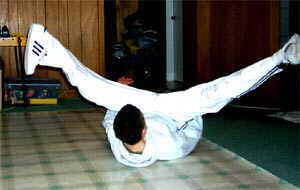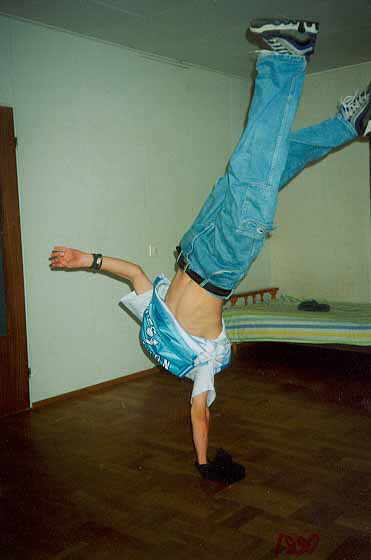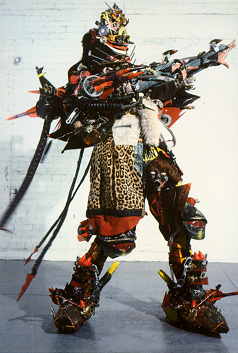The Moves
Nelson George3 offers a particularly rich description of the dance: "Each person's turn in the ring was very brief-ten to thirty seconds-but packed with action and meaning. It began with an entry, a hesitating walk that allowed him to get in step with the music for several beats and take his place "on stage." Next the dancer "got down" to the floor to do the footwork, a rapid, slashing, circular scan of sneakered feet, in which the hands support the body's weight while the head and torso revolve at a slower speed, [...] also known as the helicopter. Acrobatic transitions such as head spins, hand spins, shoulder spins, flips, and the swipe - a flip of the weight from hands to feet that also involves a twist in the body's direction-served as bridges between the footwork and the freeze. The final element was the exit, a spring back to verticality or a special movement that returned the dancer to the outside of the circle."

Performer executing the Backspin

Left: Performer executing "1990," b-boy goes into a handstand and spins as much as possible9
Relation to Technology
Technology was also an important cultural theme for early breakdancing. The generation of the 1960s, before the b-boys, had promoted Afros, tie-dye and dashikis; a return to Africa and nature. But breakdancers were creating an identity based on their own surroundings - the artificial world of urban spaces. Robot moves, “electric boogie” (described as “a dance in which an invisible electric force seems to jut from joint to joint”), and names like “Freakzoid” or “Lockatron Jon” convey a community that is comfortable with technology and claiming ownership of a technological future.

Rammellzee, Hip-hop performance artist10
Dance Moves
There are two main categories of breakdance moves: Toprock,which is performed in a standing position, and Downrock, which includes spins and other floor moves5. The b-boy/b-girl introduces his/her set through Toprock, and then transitions to the downrock through a series of drops. Once on the floor, the body is constantly rotating, and hence the dancer needs a great deal of momentum. The 6-step, in which the b-boy uses his arms to support his body above the floor while his legs walk around in a circle, is considered to be the foundational breakdance move. Some of the common Downrock moves are Freeze, Flare, Float, Kick, Spins, Suicides, Windmill, Moonwalk, Swipe, and Hand Glide. Breakdancing competitions are often referred to as Battles; and open-ended performances are termed Cyphers.

A street performer doing the Freeze(a.k.a. Pike) in the streets of Paris11
Sample Dance Moves (links off-site)
trk crew's animated moves guide